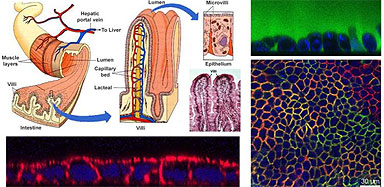A major challenge in the drug delivery field is to enhance transport of therapeutics across biological barriers such as the blood brain barrier (BBB), the small intestine, nasal, skin and the mouth mucosa. These barriers are designed by nature to keep foreign material out and only allow small molecules with specific characteristics to cross, e.g. by receptor regulated transcytosis. The pharmaceutical industry moves toward the utilization of larger biologicals as the next generation of drugs; however, this focus is resulting in a large drug delivery challenge for the industry. The result is that tissue specific transporters have to be used to carry larger molecules across biological barriers or the barriers have to be perturbed by use of molecules that weakens the barrier, e.g. by targeting tight junctions.
The Center research is focused on quantitative and mechanistic studies of single molecule transport across biological barriers and currently have projects focused on the BBB, gastrointestinal tract and mouth mucusa together with a number of pharmaceutical companies. In this work ex vivo tissue models are used and investigated by biophysical and cell biology techniques to understand transport mechanisms and quantify molecular interactions at the cell membrane level. Transport of nanoparticle systems that can function as carriers of biologicals is furthermore of particular interest, where tissue penetration and translocation is studied both by advanced fluorescence and electron microscopy imaging techniques both in vitro and in vivo. The objective of the research is to provide new knowledge of transport mechanisms and new drug delivery technology, which can be utilized by the pharmaceutical industry.
